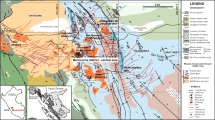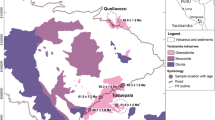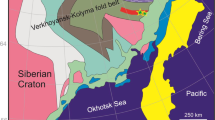Abstract
Kemess South is the only Cu–Au–Mo mine in the Toodoggone district and a major Cu and Au producer in British Columbia. Porphyry-style Cu–Au–Mo mineralization is mainly hosted by the tabular, SW-plunging, 199.6 ± 0.6-Ma Maple Leaf granodiorite, which intrudes tightly folded, SW-dipping, Permian Asitka Group siltstone and limestone and homogeneous Triassic Takla Group basalt. Southwest-dipping 194.0 ± 0.4-Ma Toodoggone Formation conglomerate, volcaniclastic, and epiclastic rocks overlie the granodiorite and Asitka Group rocks. Minor Cu–Au–Mo mineralization is hosted by the immediate Takla Group basalt country rock, whereas low-tonnage high-grade Cu zones occur beneath a 30-m-thick leached capping in supergene-altered granodiorite and in exotic positions in overlying Toodoggone Formation conglomerate. Granodiorite has an intrusive contact with mineralized and altered Takla Group basalt but displays a sheared contact with unmineralized and less altered Asitka Group siltstone. The North Block fault is a deposit-scale, E-striking, steeply S-dipping normal fault that juxtaposes the granodiorite/basalt ore body against unmineralized Asitka Group rocks. Younger NW- and NE-striking normal–dextral faults cut all rock types, orebodies, and the North Block fault with displacements of up to 100 m and result in the graben-and-horst-style block faulting of the stratigraphy and ore body. Both basalt and granodiorite host comparable vein sequence and alteration histories, with minor variations in hydrothermal mineral assemblages caused by differing protolith chemistry. Early potassic alteration (and associated early-stage Cu ± Au ± Mo mineralization) is partly replaced by phyllic and intermediate argillic alteration associated with main-stage Cu–Au–Mo mineralization. Two main-stage veins have Re–Os molybdenite ages of 201.3 ± 1.2 and 201.1 ± 1.2 Ma. These mineralization ages overlap the 199.6 ± 0.6-Ma U–Pb zircon crystallization age for the Maple Leaf granodiorite. Late-stage pyrite-rich stringer veins and related phyllic alteration assemblages are cut by anhydrite-rich, carbonate-rich, and chlorite veins. Fluids and metals associated with early-, main-, and late-stage veins were probably derived principally from the same deep magma chamber as the Maple Leaf granodiorite. These magmatic-derived fluids interacted with Asitka and Takla Group country rocks and possibly with meteoric and metamorphic fluids prior to mineralization.














Similar content being viewed by others
References
Al-Asam IS, Taylor BE, South B (1990) Stable isotope analysis of multiple carbonate samples using selective acid extraction. Chem Geol Isot Geosci 80:119–125
Bodnar RJ (1994) Synthetic fluid inclusions. XII: The system H2O-NaCl. Experimental determination of the halite liquidus and isochores for a 40 wt.% NaCl solution. Geochim Cosmochim Acta 58:1053–1063
Bodnar RJ, Vityk MO (1994) Interpretation of microthermometric data for NaCl–H2O fluid inclusions. In: De Vivo B, Frezzotti ML (eds) Fluid inclusions in minerals: methods and applications. Virginia Polytechnic Institute and State University, Blacksburg, pp 117–131
Bodnar RJ, Burnham CW, Sterner SM (1985) Synthetic fluid inclusions in natural quartz. III: determination of phase equilibrium properties in the system H2O–NaCl to 1000 degrees C and 1500 bars. Geochim Cosmochim Acta 49:1861–1873
Brown PE, Hagemann SG (1995) MacFlinCor and its application to fluids in archaean lode-gold deposits. Geochim Cosmochim Acta 59:3943–3952
Clark JR, Williams-Jones AE (1991) 40Ar/39Ar ages of epithermal alteration and volcanic rocks in the Toodoggone Au-Ag district, north-central British Columbia (94E). British Columbia Ministry Energy, Mines and Petroleum Research, Geological Fieldwork 1990, Paper 1991-1, pp 207–216
Claypool GE, Holser WT, Kaplan IR, Sakai H, Zak I (1980) The age curves of sulfur and oxygen isotopes in marine sulfate and their mutual interpretation. Chem Geol 28:199–260
Coplen TB, Kendall C, Hopple J (1983) Comparison of stable isotope reference samples. Nature 302:236–238
Diakow LJ (2001) Geology of the southern Toodoggone River and northern McConnell Creek map areas, north-central British Columbia. British Columbia Ministry of Energy, Mines and Petroleum Resources, Open file map 2001-1, 1:50,000 scale
Diakow LJ (2004) Geology of the Samuel Black Range between the Finlay river and Toodoggone river, Toodoggone river map area, north-central British Columbia (parts of NTS 94E/2,6 and 7). British Columbia Ministry of Energy, Mines and Petroleum Resources, Open file map 2004-4, 1:50,000 scale
Diakow LJ (2006a) Geology between the Finlay River and Chukachida Lake, central Toodoggone River map area, north-central British Columbia (parts of NTS 94E/2, 6, 7, 10 and 11). British Columbia Ministry of Energy, Mines and Petroleum Resources, Open file map 2006-4, 1:50,000 scale
Diakow LJ (2006b) Toodoggone’s Au–Cu setting unraveled. Mineral Exploration Roundup 06. Westin Bayshore, Vancouver, pp 14–15
Diakow LJ, Panteleyev A, Schroeter TG (1991) Jurassic epithermal prospects in the Toodoggone river area, northern British Columbia: examples of well preserved, volcanic-hosted, precious metal mineralization. Econ Geol 86:529–554
Diakow LJ, Panteleyev A, Schroeter TG (1993) Geology of the Early Jurassic Toodoggone Formation and gold-silver deposits in the Toodoggone river map area, northern British Columbia. British Columbia Ministry of Energy, Mines and Petroleum Resources, pp 72
Diakow LJ, Nixon GT, Rhodes R, Lane B (2005) Geology between the Finlay and Toodoggone rivers, Toodoggone river map area, north-central British Columbia (parts of NTS 94E/2, 6 and 7). British Columbia Ministry of Energy, Mines and Petroleum Resources, Open file map 2005-3, 1:50,000 scale
Dickinson JM (2006) Jura–Triassic magmatism and porphyry Au–Cu mineralization at the Pine deposit, Toodoggone district, north-central British Columbia. M.Sc. thesis, University of British Columbia, Vancouver, pp 116
Duuring P, Rowins SM, Dickinson JM, McKinley BSM, Diakow LJ, Kim Y-S, Creaser RA (2008) Examining potential genetic links between Jurassic porphyry Cu–Au ± Mo and epithermal Au ± Ag mineralization in the Toodoggone district of north-central British Columbia, Canada. Miner Deposita (this volume)
Field CW, Gustafson LB (1976) Sulfur isotopes in the porphyry copper deposit at El Salvador, Chile. Econ Geol 71:1533–1548
Goldstein RH, Reynolds TJ (1994) Systematics of fluid inclusions in diagenetic minerals. SEPM Short Course 31:199
Hagemann SG, Brown PE (1996) Geobarometry in archaean lode-gold deposits. Eur J Mineral 8:937–960
Kusakabe M, Nakagawa S, Hori M, Matsuhisa Y, Ojeda JM, Serrano L (1984) Oxygen and sulfur isotopic compositions of quartz, anhydrite and sulfide minerals from the El Teniente and Rio Blanco porphyry copper deposits, Chile. Bull Geol Surv Jpn 35:583–614
Macdonald AJ, Spooner ETC (1981) Calibration of a Linkam TH 600 programmable heating–cooling stage for microthermometric examination of fluid inclusions. Econ Geol 76:1248–1258
Markey RJ, Stein HJ, Morgan JW (1998) Highly precise Re–Os dating for molybdenite using alkaline fusion and NTIMS. Talanta 45:935–946
Markey RJ, Stein HJ, Hannah JL, Selby D, Creaser RA (2007) Standardizing Re–Os geochronology: a new molybdenite reference material (Henderson, USA) and the stoichiometry of Os salts. Chem Geol 244:74–87
McKinley BSM (2006) Geological characteristics and genesis of the Kemess North porphyry Au–Cu–Mo deposit, Toodoggone district, north-central British Columbia, Canada. M.Sc. thesis, University of British Columbia, Vancouver, British Columbia, Canada, pp 136
Monger J, Church B (1977) Revised stratigraphy of the Takla Group, north-central British Columbia. Can J Earth Sci 14:318–326
Monger JWH, Nokleberg WJ (1996) Evolution of the northern North American Cordillera: generation, fragmentation, displacement, and accretion of successive North American plate margin arcs. Geology and Ore Deposits of the American Cordillera, Reno/Sparks, pp 1133–1152
Mortensen JK, Ghosh DK, Ferri F (1995) U–Pb geochronology of intrusive rocks associated with copper–gold porphyry deposits in the Canadian Cordillera. In: Schroeter TG (ed) Porphyry deposits of the northwestern Cordillera of North America. Canadian Institute of Mining and Metallurgy, Montreal, pp 142–160
Ohmoto H, Lasaga AC (1982) Kinetics of reactions between aqueous sulfates and sulfides in hydrothermal systems. Geochimt Cosmochim Acta 46:1727–1745
Ohmoto H, Rye RO (1979) Isotopes of sulfur and carbon. In: Barnes HL (ed) Geochemistry of hydrothermal ore deposits. 2nd edn. Wiley, New York, pp 509–567
O’Neil JR, Clayton RN, Mayeda TK (1969) Oxygen isotope fractionation in divalent metal carbonates. J Chem Phys 51:5547–5558
Rebagliati CM, Bowen BK, Copeland DJ, Niosi DWA (1995) Kemess South and Kemess North porphyry gold-copper deposits, northern British Columbia. In: Schroeter TG (ed) Porphyry deposits of the northwestern Cordillera of North America. Canadian Institute of Mining and Metallurgy, Montreal, pp 377–396
Roedder E (1984) Fluid inclusions. Rev Mineral 12:644
Roedder E, Bodnar RJ (1980) Geologic pressure determinations from fluid inclusion studies. Annu Rev Earth Planet Sci 8:263–301
Rollinson HR (1993) Using geochemical data: evaluation, presentation, interpretation. Longman, Harlow, p 352
Seedorff E, Dilles JH, Proffett JM Jr., Einaudi MT, Zurcher L, Stavast WJA, Johnson DA, Barton MD (2005) Porphyry deposits; characteristics and origin of hypogene features. Econ Geol 100th Anniversary Volume:251–298
Selby D, Creaser RA (2004) Macroscale NTIMS and microscale LA-MC-ICP-MS Re–Os isotopic analysis of molybdenite; testing spatial restrictions for reliable Re–Os age determinations, and implications for the decoupling of Re and Os within molybdenite. Geochim Cosmochim Acta 68:3897–3908
Sharp Z (2006) Principles of stable isotope geochemistry. Pearson Prentice Hall, Upper Saddle River, p 344
Shepherd TJ, Rankin AH, Alderton DHM (1985) A practical guide to fluid inclusion studies. Blackie, Glasgow, p 239
Sillitoe RH (2000) Gold-rich porphyry deposits; descriptive and genetic models and their role in exploration and discovery. Rev Econ Geol 13:315–345
Sillitoe RH (2005) Supergene oxidized and enriched porphyry copper and related deposits. Econ Geol 100th Anniversary Volume:723–768
Taylor HP Jr. (1979) Oxygen and hydrogen isotope relationships in hydrothermal mineral deposits; 2. In: Barnes HL (ed) Geochemistry of hydrothermal ore deposits. Wiley, New York, pp 236–277
Turner FJ (1981) Metamorphic petrology: mineralogical, field, and tectonic aspects. McGraw-Hill, New York, p 524
Valley JW (1986) Stable isotope geochemistry of metamorphic rocks. Rev Mineral 16:445–489
Veizer J, Ala D, Azmy K, Bruckschen P, Buhl D, Bruhn F, Carden GAF, Diener A, Ebneth S, Godderis Y, Jasper T, Korte C, Pawellek F, Podlaha OG, Strauss H (1999) 87Sr/86Sr, d13C and d18O evolution of Phanerozoic seawater. Chem Geol 161:59–88
Zheng YF, Hoefs J (1993) Carbon and oxygen isotopic covariations in hydrothermal calcites; theoretical modeling on mixing processes and application to Pb–Zn deposits in the Harz Mountains, Germany. Miner Deposita 28:79–89
Acknowledgments
The Kemess South study is part of a larger NSERC-CRD grant research project between the University of British Columbia, Northgate Minerals Ltd., and Stealth Minerals Ltd. The latter two companies are thanked for providing generous financial and logistical support for fieldwork in the Toodoggone district. Carl Edmunds, Brian Kay, Ron Konst, Brian O’Connor, Gary Parrup, and Chris Rockingham from Northgate Minerals Ltd. are thanked for providing logistical support and access to the Kemess South pit and drill core. Field assistants, Andy Orr and Colin Smith, contributed greatly with their enthusiasm and dedication during fieldwork and subsequent laboratory work. Greg Dipple is thanked for his advice regarding the interpretation of C and O isotope data. Greg Arehart, Thomas Bissig, Alan H. Clark, Jean Cline, Steve Garwin, Steve Kesler, David Love, W.J. McMillan, and Larry Meinert are thanked for their careful reviews of the manuscript and helpful comments. The first author acknowledges financial support from the second stage of the Brain Korea 21 project at Pukyong National University. The Radiogenic Isotope Facility at the University of Alberta is supported, in part, by an NSERC Major Resources Support Grant.
Author information
Authors and Affiliations
Corresponding author
Additional information
Editorial handling: T. Bissig
Rights and permissions
About this article
Cite this article
Duuring, P., Rowins, S.M., McKinley, B.S.M. et al. Magmatic and structural controls on porphyry-style Cu–Au–Mo mineralization at Kemess South, Toodoggone District of British Columbia, Canada. Miner Deposita 44, 435–462 (2009). https://doi.org/10.1007/s00126-008-0227-x
Received:
Accepted:
Published:
Issue Date:
DOI: https://doi.org/10.1007/s00126-008-0227-x




